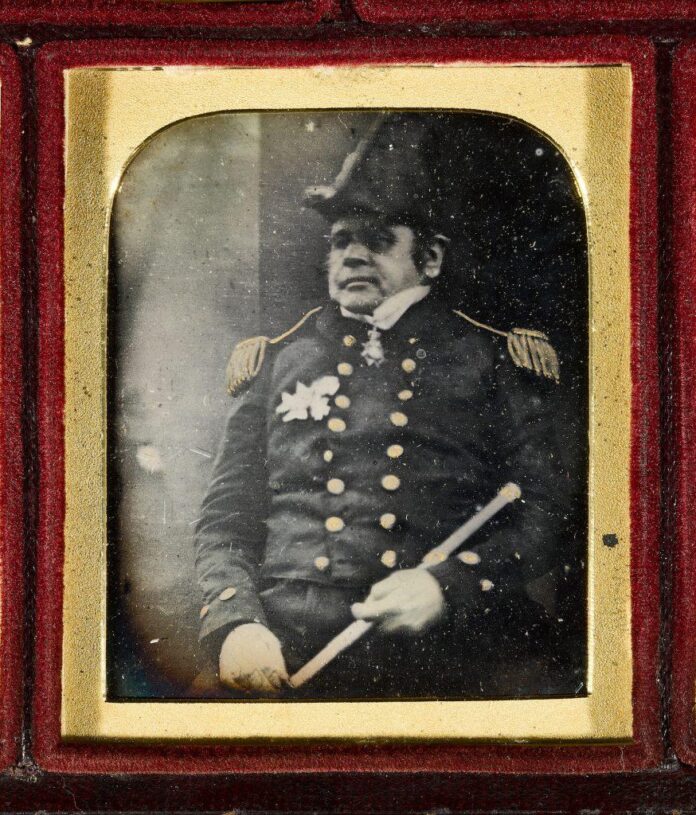Sotheby’s has achieved a stellar auction result with the sale of a set of rare, recently rediscovered daguerrotypes it says were unseen for 178 years. The collection of photographs of Sir John Franklin and his senior officers who sailed on the doomed exploration ships HMS Erebus and Terror sold yesterday in London for £444,500 ($545,580), or more than double the high £200,000 ($245,000) estimate. They were offered as part of the auction house’s “Travel, Atlases, Maps & Photographs” sale.
The price is among the highest ever paid for daguerrotypes, though the all-time high is still the $922,4888 that was paid 20 years ago for a work by French photographer Girault de Prangey’s (1842), which sold at Christie’s London in May 2003.
Sotheby’s called the Franklin daguerrotypes one of the most significant artifacts for the history of photography and polar exploration rediscovered in recent times. The photographs emerged from the direct descendants of Franklin, a British Royal Navy officer and Arctic explorer.
They were originally commissioned by his wife, Lady Jane Franklin, and were taken by Richard Beard studio of Regent Street in London in May 1845 aboard HMS Erebus just three days before it set sail. It never returned.

Pre-eminent set of daguerreotypes of Franklin’s lost expedition to the Northwest passage. Photo courtesy Sotheby’s.
Both the Erebus and Terror were lost, and all 129 men on board died. It marked “the worst disaster in the history of British polar exploration,” according to the Royal Museums, Greenwich.
Dozens of expeditions were subsequently launched to find the ships, and many of the objects discovered during these missions are now held in the National Maritime Museum.
Fresh evidence from the shipwrecks discovered more recently, in 2014 and 2016, has offered new insight, while novels, TV series, and archaeological investigations have all attempted to shed light on the crew’s final moments.
Meanwhile, the daguerrotypes were produced when photography was still in its infancy. These early prints are the last photographs of 14 members of the expedition who the British sent to explore 500 kilometers (310 miles) of Arctic coastline to finish charting the Northwest Passage, the important sea route between the Atlantic and Pacific oceans.
British authorities invited Franklin, who was 59 at the time, as expedition commander alongside James Fitzjames as commander of HMS Erebus and Francis Crozier as commander of HMS Terror.
All three men feature in the daguerreotype set and are shown posing in their uniforms along with 11 senior members of the crew of HMS Erebus.
They were supplied with three years’ worth of preserved food and the Franklin expedition set sail from Greenhithe, England on May 19, 1845, with a crew of 24 officers and 110 men. After two years with no word from the men, Franklin’s wife urged the Admiralty to send a search party.

Captain Francis Crozier. Photo courtesy Sotheby’s.
However, because of the ample food supply they departed with, the Admiralty waited another year before initiating a search and offered a reward equal to £2 million ($2.4 million) today. “Franklin’s name and the money led to many failed searches, with more men and ships lost than in the expedition itself,” according to Sotheby’s.
Years later, in 1854, Scottish explorer John Rae determined that both ships had become icebound with the men dying from the cold and in some cases resorting to cannibalism.
In 2014, HMS Erebus was discovered by Canadian government agency Parks Canada in collaboration with Inuit communities, followed by the discovery of HMS Terror in 2016.
The only other known set of the daguerreotypes is in the collection of the Scott Polar Research Institute (SPRI), in Cambridge, England. The SPRI set includes 12 portraits—lacking the images of Robert Sargent and Francis Crozier, both found in the present lot, according to Sotheby’s.
More Trending Stories:

























